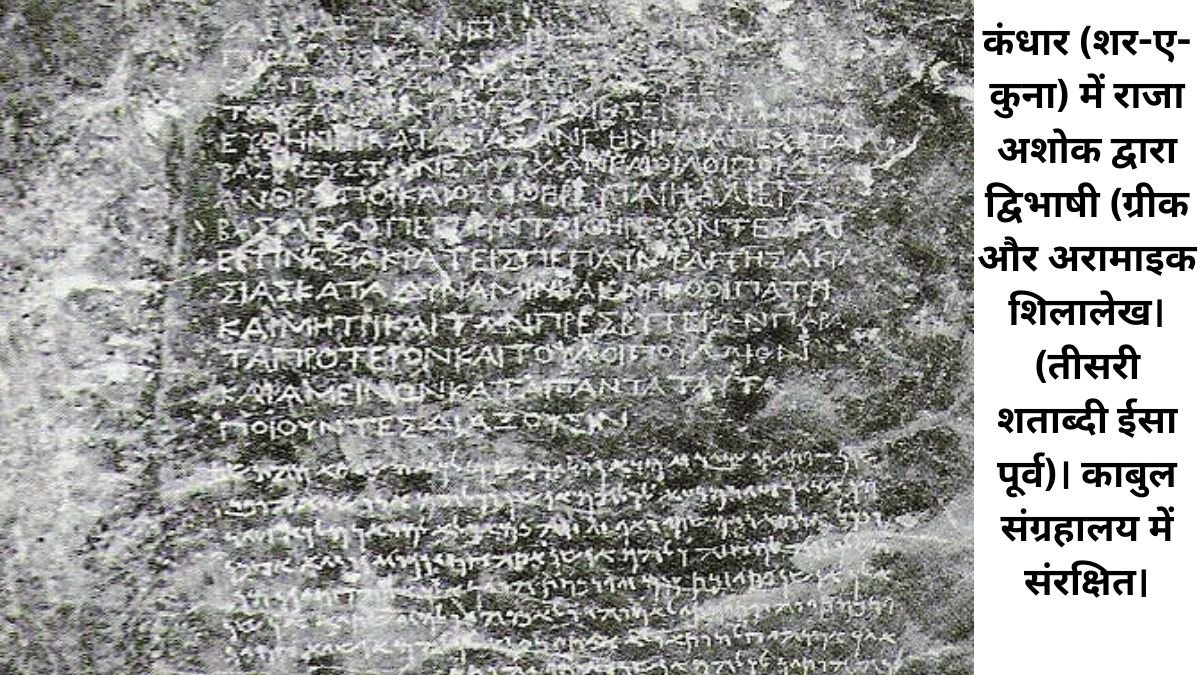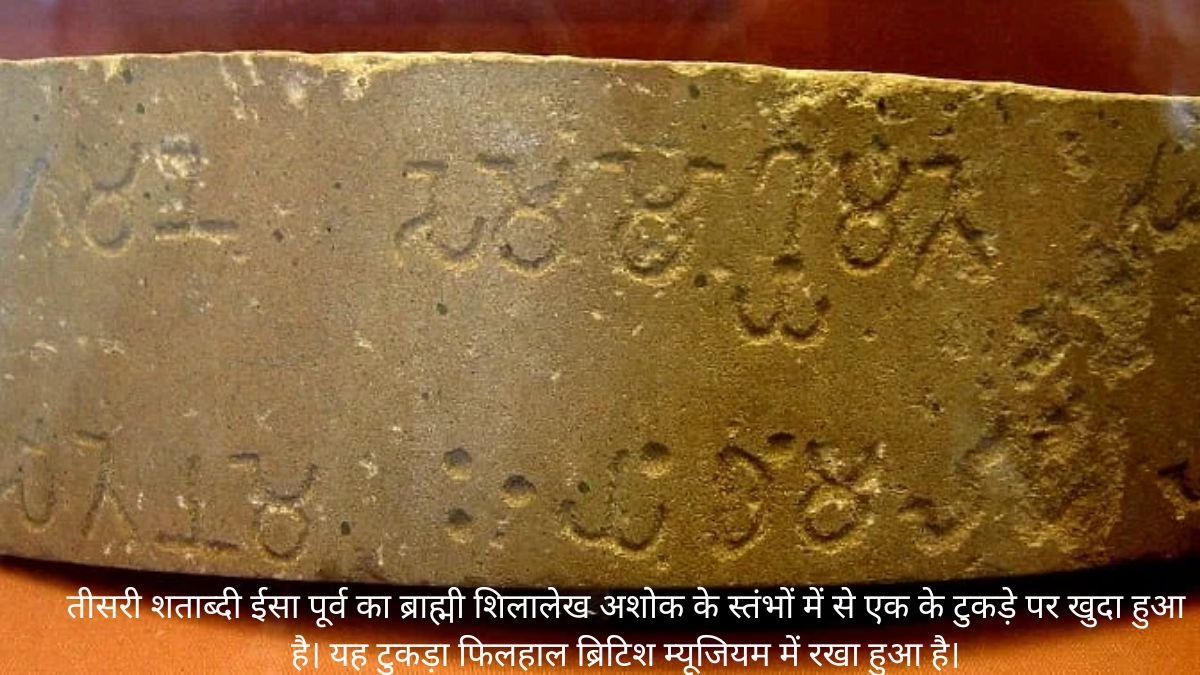The Brahmi script holds immense historical significance as the earliest writing system developed in India after the Indus script. It has played a pivotal role, serving as the foundation for numerous modern Indian scripts and several hundred scripts found in Southeast and East Asia.

Features of the Brahmi Script:
Unlike representing individual consonant (C-C) and vowel (V-V) sounds, the Brahmi script’s basic writing units represent various types of syllables, such as CV, CCV, CCCV, CVC, and VC. While it operates on a syllabic basis, the clear distinction between the V (vowels) and C (consonants) components of Brahmi symbols classifies it as an alpha-syllabic writing system.
Origin and History of the Brahmi Script:
Debate on Semitic Influence:
One aspect of the Brahmi script’s origin revolves around the question of whether it derived from another script or was an indigenous invention. In the late 19th century, Georg Bühler proposed the idea that Brahmi was derived from a Semitic script and later adapted by Brahmin scholars to fit the phonetics of Sanskrit and Prakrit.
Semitic Influence through Persian Achaemenid Empire:
During the 6th century BCE, when the Persian Achaemenid Empire controlled the Indus Valley, India came into contact with Semitic writing. Aramaic, a North Semitic script, was employed as the language of the ancient Persian government administration, leading to the creation of official records using this script.
Kharosthi and Brahmi Scripts:
Around the same time, another script called Kharosthi developed in the region, particularly dominant in the Indus Valley. Meanwhile, the Brahmi script gained prevalence in the rest of India and other parts of South Asia. While the adaptation of Kharosthi from Semitic is confirmed, the connection between Brahmi and Semitic remains uncertain.
Graffiti Signs and Tamil-Nadu:
Professor K. Rajan proposed an alternative theory suggesting that the precursor to the Brahmi script was a system of symbols found on graffiti signs in Tamil-Nadu, South India. These graffiti signs, discovered on pottery and rocks, often appear alongside Brahmi inscriptions, indicating a possible link between the two systems.
Indus Script Influence:
A third hypothesis proposes that Brahmi may have derived from the Indus script, which was used during the Indus Civilization but ceased to be in use afterward. Supporters of this theory point to resemblances between certain signs in both scripts. However, due to the lack of physical evidence directly connecting the two writing systems, this view remains speculative and difficult to verify.
The Antiquity of the Brahmi Script:
Early Examples and the Mauryan Empire:
Until a few decades ago, the earliest securely dated examples of the Brahmi script were from the 3rd century BCE, during the reign of the Mauryan Empire in India. These examples were found in the form of state edicts spread across northern and central India, known as the Edicts of Ashoka or Ashokan Edicts, issued by the Indian emperor Ashoka (268 BCE to 232 BCE).
Claims of Earlier Origin:
Some scholars argue that the Brahmi script predates the 3rd century BCE. They support this claim by referring to the composition of the Brahmanas, a set of texts associated with Vedic literature during the 6th century BCE. The presence of prose in the Brahmanas suggests the existence of writing technology to support its development. Additional evidence comes from the work of Panini, an esteemed ancient Indian grammarian from the 5th or 4th century BCE, whose grammatical analysis of Sanskrit would have been challenging to produce in a preliterate society. The knowledge of writing in India is also documented by writers who accompanied Alexander the Great to India, approximately a century before the time of Ashoka.
During the late 20th century CE, there was growing evidence suggesting that Brahmi originated before the 3rd century BCE. Archaeologists excavating in Anuradhapura, Sri Lanka, discovered Brahmi inscriptions on pottery dating back to the period of 450-350 BCE.
These early inscriptions consist of single letters, and their dating has been established using radiocarbon dating techniques. The language used in these inscriptions is North Indian Prakrit, which is an Indo-Aryan language.
The development of the Brahmi script primarily represented the Prakrit language in most examples found in North and Central India. However, the Ashokan Inscriptions already exhibited slight regional variations in the Brahmi script.
In South India, particularly in Tamil Nadu, Brahmi inscriptions represented the Tamil language, which belongs to the Dravidian language family and has no linguistic affiliation with Indo-Aryan languages like Sanskrit or Prakrit.
Some Tamil examples of Brahmi inscriptions were found on inscribed potsherds in Uraiyur, dating back to the 1st century BCE or 1st century CE. There is also evidence of an early form of Tamil in Brahmi inscriptions discovered in Arikamedu, dated to the early centuries CE.
At this stage, specific Brahmi characters adapted to suit Tamil phonetics were already in use. However, the earliest securely dated examples of Brahmi found in Anuradhapura, Sri Lanka, did not include Tamil, but rather represented the Prakrit language.
By the 2nd century BCE, the usage of the Brahmi script became more widespread, and distinct regional variations emerged. Ashokan inscriptions were found on carved rocks, caves, stone slabs, and rock pillars. There are also examples of short Brahmi inscriptions on small seals made of materials like ivory, bone, stone, and terracotta, dating to the Mauryan period.

Additionally, Brahmi inscriptions appeared on potsherds and copper plates. As Buddhism became the dominant faith in India, Brahmi inscriptions were found on monumental constructions known as “donative records,” which stated the names of different donors. In the early 2nd century BCE, Brahmi inscriptions started appearing on coins.
The use of perishable materials as a writing medium has been a widespread practice in South Asia, particularly the use of palm leaf and birch bark. These materials were portable, affordable, and suitable for writing. However, direct material evidence of palm leaf and birch bark usage before the time of the Ashokan Inscriptions has not been found. This lack of direct evidence may be due to the bias in the archaeological record caused by the destruction of perishable materials over time rather than the absence of a written tradition on such materials.
Indirect evidence of possible perishable writing surfaces has been found at Sringaverapura in North India, including traces of birch wood dating to the period of the 10th to 7th-century BCE. D. Chakrabarti also mentions the presence of bone items that could have been styluses used for writing on palm leaves and birch bark, although these objects might have also served as arrows.
The earliest identifiable use of the Brahmi script on ceramic surfaces was for indicating ownership of the item. Around the mid-3rd century BCE, Brahmi started being used for official communication, such as on seals and the Ashokan Inscriptions. In subsequent centuries, Brahmi began to be employed in religious contexts, both in architectural elements and for the transmission of religious texts.
If we accept the proposition that the use of Brahmi predates the earliest known archaeological examples, we could speculate that its earliest usage was for recording commercial transactions and other forms of record-keeping.

This speculation is based on the observation that writing systems tend to emerge when there is a pressing need to record information due to factors such as urbanization, social complexity, taxation, and the reliance on redistribution systems to support growing population pressures. In North India, this process was already well underway by the 7th century BCE.
It is unlikely that such a level of social and economic transformation, including the rise of cities and kingdoms, could have occurred without the presence of writing. If the work of Panini, a renowned grammarian, was produced with the aid of the Brahmi script, we can further infer that the system underwent refinement and improvement by North Indian grammarians during the 5th to 4th century BCE.
Scripts derived from Brahmi
During its long history of development, a large number of scripts have been derived from Brahmi. Many scripts derived from Brahmi have been adapted to the phonetics of many different languages, giving rise to many script variations. The origins of many writing systems currently in use throughout Asia can be traced to the Brahmi script, including Gurmukhi, Kanaris, Sinhalese, Telugu, Thai, Tibetan, Javanese and many others.
Article sources: worldhistory